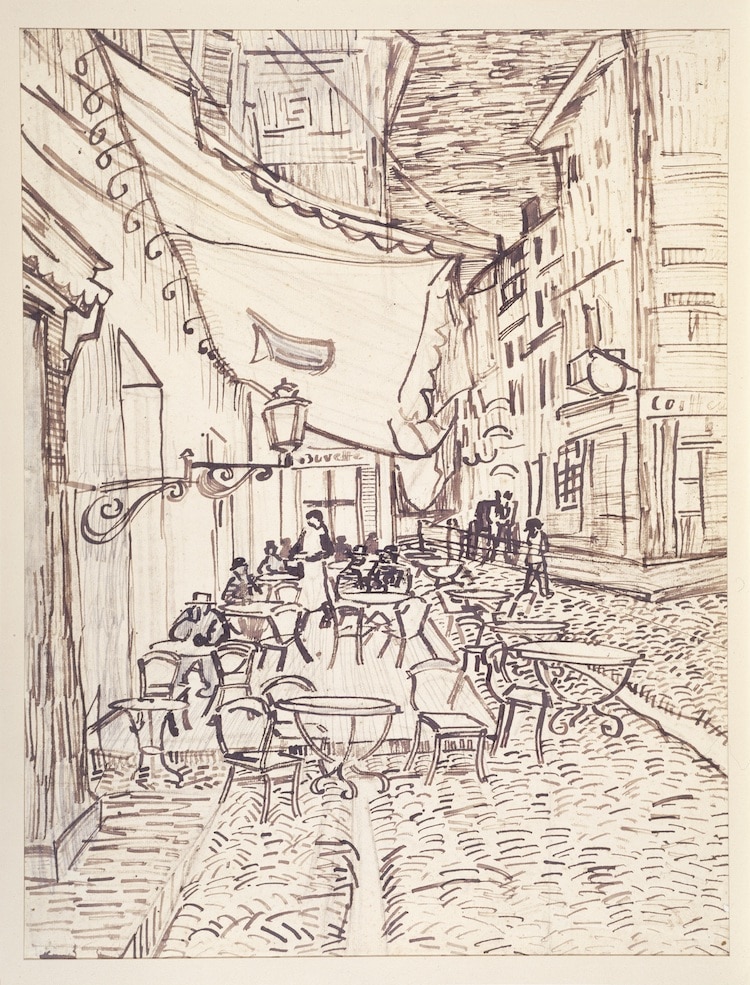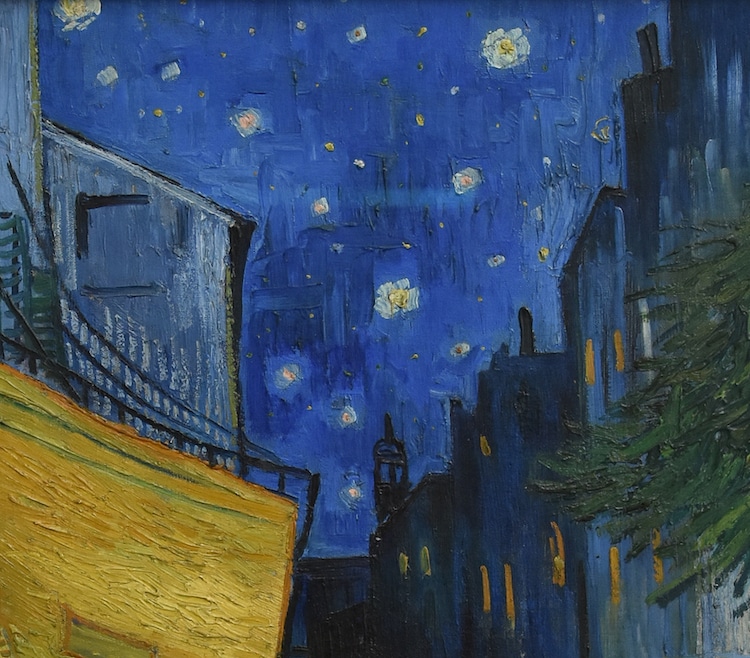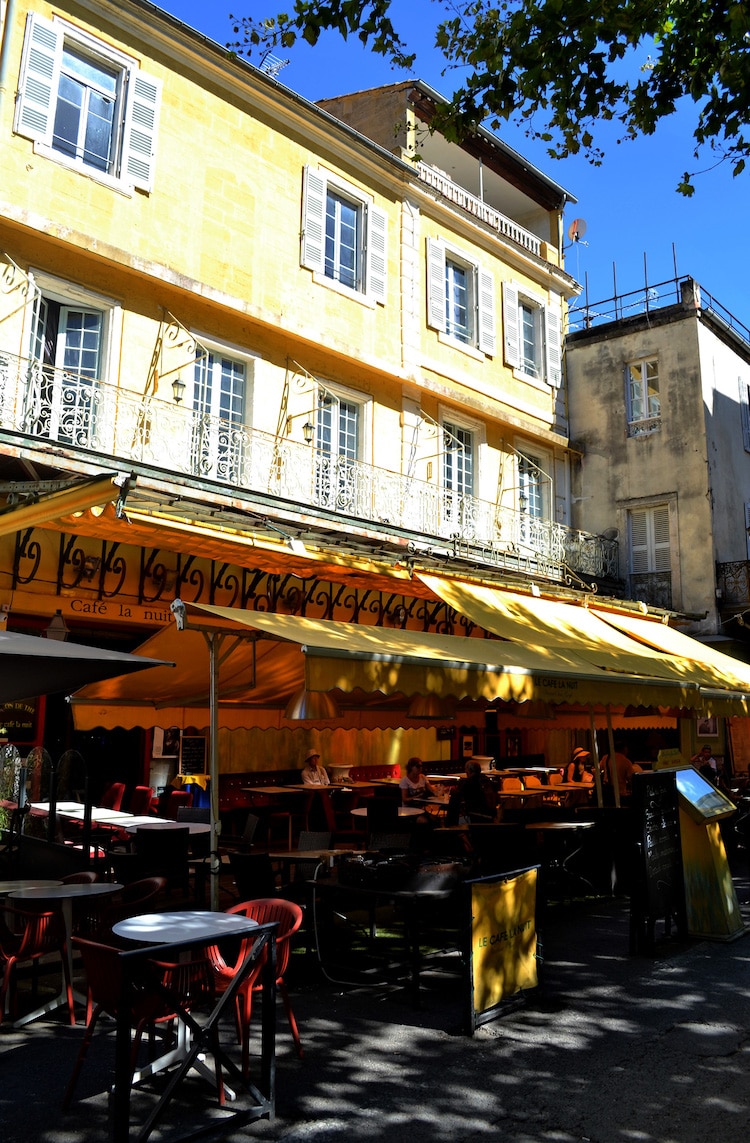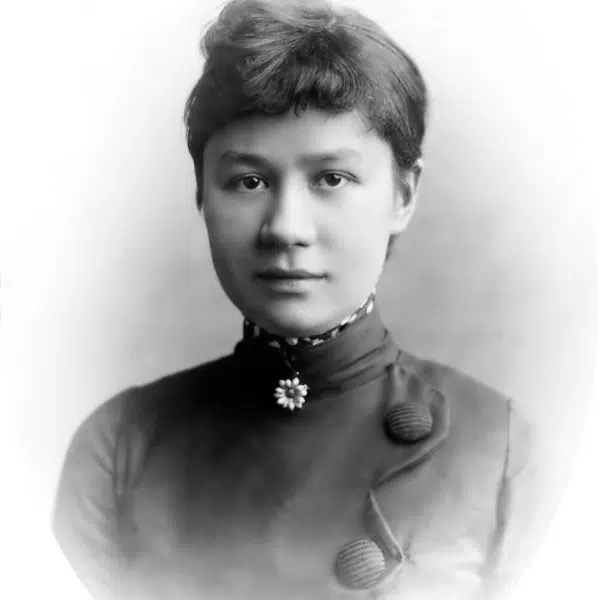
Vincent van Gogh, “Café Terrace at Night,” 1888 (Photo: Paul Hermans via Wikimedia Commons, Public domain)
In 1888, Vincent van Gogh exchanged the electric nightlife of Paris for the tranquility of the French countryside. There, in Arles, the Dutch artist flourished creatively, even as his mental health declined. He created 200 paintings and over 100 drawings inspired by the idyllic landscape, local people, and charming towns. Among the many iconic works that emerged from this year in Arles was the masterpiece, Café Terrace at Night.
Completed in September 1888, this blue-and-yellow canvas depicts a snapshot of a street in Arles, situated by the Place du Forum and the rue de Palais. At an unknown late hour, people are huddled at the outdoor terrace of a local cafe as folks walk by on the street. Nestled between the two rows of buildings is a glimpse of a vibrant starry sky, reminiscent of Van Gogh's other famous work, The Starry Night. Like the rest of the Post-Impressionist's oeuvre, the Café Terrace at Night was underappreciated during Van Gogh's lifetime. Today, however, it is recognized as one of the artist's most significant works.
Scroll down to learn 10 interesting facts about Café Terrace at Night.
Learn 10 facts about Van Gogh's painting Café Terrace at Night.

Vincent van Gogh, “Self-Portrait,” 1889 (Photo: Szilas via Wikimedia Commons, Public domain)
Title | Café Terrace at Night |
Artist | Vincent van Gogh |
Year | 1888 |
Medium | Oil on canvas |
Size | 31.8 in × 25.7 in (80.7 cm × 65.3 cm) |
Location | Kröller-Müller Museum (Otterlo, Netherlands) |
It is based on a real place.
Unlike his friend and artistic rival Gauguin, Van Gogh preferred to paint from real life and the Café Terrace at Night was no exception. He set up his easel at the corner of the Place du Forum and captured the sight of a busy local cafe lit by artificial light. While he retained most of the key features of the area, he did omit some architecture and embellish the ambiance with his own stylistic choices.
“I enormously enjoy painting on the spot at night. In the past, they used to draw, and paint the picture from the drawing in the daytime. But I find that it suits me to paint the thing straightaway,” he wrote in a letter to his sister.
He made a drawing of the painting first.
Van Gogh was no stranger to hard work and oftentimes created numerous preparatory drawings—practicing the composition and figures—prior to picking up his paintbrush. He also made a sketch of the Café Terrace at Night in ink, rendering the narrow street-view nearly the same way it is portrayed in color. The only significant difference between the two pieces appears to be the sky, which in the sketch is filled with dozens of hatch marks instead of stars.

Vincent van Gogh, Drawing for “Café Terrace at Night,” 1888 (Photo: Dallas Museum of Art via Wikimedia Commons, Public domain)
It features the first depiction of Van Gogh's iconic starry sky.
The Starry Night is, without doubt, one of Van Gogh's most iconic works of art. However, the splendid canvas was not the first rendition of the expressive skies—he first used the starry motif in Café Terrace at Night. In the small space between the architecture, viewers can see a lavish blue sky dotted with shimmering yellow dots.

Vincent van Gogh, “The Starry Night,” 1889 (Photo: MoMA via Wikimedia Commons, Public domain)
The stars in the painting are in the right location.
According to Van Gogh's catalog of letters, Café Terrace at Night was known to have been completed in September of 1888. However, researchers narrowed down the dates that he worked on the piece to the 17th and 18th of the month. With this information, they were able to compare the arrangement of stars in Van Gogh's painting to what they would have actually looked like at that period of time. Ultimately, they realized that the artist placed the stars exactly where they would have been on those dates.

Vincent van Gogh, Detail of “Café Terrace at Night,” 1888 (Photo: Paul Hermans via Wikimedia Commons, Public domain)
He did not use the color black anywhere in the painting.
Although a painting with “at night” in the title conjures an idea of a darkly rendered scene, Van Gogh managed to create the painting without using the color black. Instead, he relies on an array of different blues and yellows to convey the scene.
“This is a night painting without black, with nothing but beautiful blue and violet and green and in this surrounding the illuminated area colors itself sulfur pale yellow and citron green,” he explained in a letter.
Some think the painting is associated with the Last Supper.
In 2013, academics proposed that Van Gogh's painting may include references to the Last Supper. Most notably among the evidence are the inclusion of 12 figures on the café's terrace—the same amount of people that are described in the Bible— and the yellow “holy” light encompassing them (similar to a halo).

Vincent van Gogh, Detail of “Café Terrace at Night,” 1888 (Photo: Paul Hermans via Wikimedia Commons, Public domain)
Café Terrace at Night might depict a scene from a novel.
In a letter to his sister Wilhelmina, Van Gogh says:
“You never told me if you had read Guy de Maupassant’s Bel-ami, and what you now think of his talent in general. I say this because the beginning of Bel-ami is precisely the description of a starry night in Paris, with the lighted cafés of the boulevard, and it’s something like the same subject that I’ve painted just now.”
Due to this description, art historians believe Café Terrace at Night depicts a scene from Maupassant's novel, which describes a group of people drinking at night, illuminated by the lights of a building.
It might have also been inspired by a friend's painting.
However, the novel Bel-ami might not have been Van Gogh's only influence. Although he discusses a starry night in his letter to Wilhelmina, there was no such descriptor in Maupassant's novel.
Instead, historians believe that the composition of the painting—with the narrow perspective and rich blue color palette—may have been based on the work of a fellow Post-Impressionist, Louis Anquetin. Famous for his Cloisonnist style, Anquetin created Avenue de Clichy: 5 PM one year prior to Van Gogh's work, and there is a striking resemblance between the two pieces.

Left: Vincent van Gogh, “Café Terrace at Night,” 1888 (Photo: Paul Hermans via Wikimedia Commons, Public domain)
Right: Louis Anquetin, “Avenue de Clichy: 5 PM,” 1887 (Photo: Wadsworth Atheneum Museum of Art via Wikimedia Commons, Public domain)
It has been known by three different titles.
Before it became known as the Café Terrace at Night, the painting was exhibited under the title Coffeehouse, in the evening in 1891, and alternatively known as The Cafe Terrace on the Place du Forum.
The café depicted in the painting still exists.
While many of the sights from famous paintings can no longer be found, the café from Van Gogh's painting not only still exists, but is still operating as well. Renamed Café Van Gogh in the artist's honor, this destination restaurant was restored in the 1990s to resemble its appearance in the famous painting.

Photo of Café Van Gogh in Arles, 2016 (Photo: John via Wikimedia Commons, CC BY-SA 4.0
Related Articles:
Newly Identified Van Gogh Drawing Goes on Display for First Time Ever
How Van Gogh’s ‘The Starry Night’ Came to Be and Continues to Inspire Artists
Meet Theo van Gogh: Vincent’s Younger Brother and One of History’s Most Important Art Dealers
20 Inspiring Van Gogh Quotes to Keep You Motivated to Create






















































































